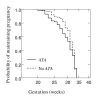Polymorphisms in immunoregulatory genes and the risk of histologic chorioamnionitis in Caucasoid women: a case control study
- PMID: 15723707
- PMCID: PMC554771
- DOI: 10.1186/1471-2393-5-4
Polymorphisms in immunoregulatory genes and the risk of histologic chorioamnionitis in Caucasoid women: a case control study
Abstract
BACKGROUND: Chorioamnionitis is a common underlying cause of preterm birth (PTB). It is hypothesised that polymorphisms in immunoregulatory genes influence the host response to infection and subsequent preterm birth. The relationship between histologic chorioamnionitis and 22 single nucleotide polymorphisms in 11 immunoregulatory genes was examined in a case-control study. METHODS: Placentas of 181 Caucasoid women with spontaneous PTB prior to 35 weeks were examined for histologic chorioamnionitis. Polymorphisms in genes IL1A, IL1B, IL1RN, IL1R1, tumour necrosis factor (TNF), IL4, IL6, IL10, transforming growth factor beta-1 (TGFB1), Fas (TNFRSF6), and mannose-binding lectin (MBL2) were genotyped by polymerase chain reaction and sequence specific primers. Multivariable logistic regression including demographic and genetic variables and Kaplan-Meier survival analyses of genotype frequencies and pregnancy outcome were performed. RESULTS: Sixty-nine (34%) women had histologic evidence of acute chorioamnionitis. Carriage of the IL10-1082A/-819T/592A (ATA) haplotype [Multivariable Odds ratio (MOR) 1.9, P = 0.05] and MBL2 codon 54Asp allele (MOR 2.0, P = 0.04), were positively associated with chorioamnionitis, while the TNFRSF6-1377A/-670G (AG) haplotype (MOR 0.4, P = 0.03) and homozygosity for TGFB1-800G/509T (GT) haplotype (MOR 0.2, P = 0.04) were negatively associated. CONCLUSION: These findings demonstrate that polymorphisms in immunoregulatory genes IL10, MBL2, TNFRSF6 and TGFB1 may influence susceptibility to chorioamnionitis.
Figures


References
-
- Mueller-Heubach E, Rubinstein DN, Schwarz SS. Histologic chorioamnionitis and preterm delivery in different patient populations. Obstet Gynecol. 1990;75:622–626. - PubMed
-
- Bennett PR, Rose MP, Myatt L, Elder MG. Preterm labor: stimulation of arachidonic acid metabolism in human amnion cells by bacterial products. Am J Obstet Gynecol. 1987;156:649–655. - PubMed
LinkOut - more resources
Full Text Sources
Research Materials
Miscellaneous

